Traveling with Grace: Beginning to Explore Sweden
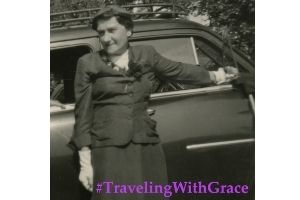
Grace begins her travels through Sweden, this week landing in Goteborg and traveling to Karlstad and Falum! Special thanks go to JMM volunteer Harold Toppall for his transcriptions of Grace’s travel diary.
To read more of Grace’s travels, click here.
June 17, 1950
Gothenberg, Sweden
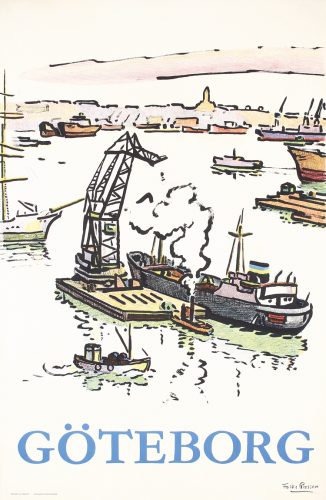
We decked in the wee hrs. tho it didn’t get real dark all night. Breakfast in cabin at 6:45 then up on deck to see the excitement. They checked our passports & declarations very quickly. Our chauffeur-guide Mr. George Anderson, from Am[erican] Ex[press] came aboard to greet us & I think we are going to like him.
I walked down the gangplank alone. They didn’t bother to examine our luggage & we went right out to the waiting car, a 7 passenger 1949 deSoto & very comfortable.
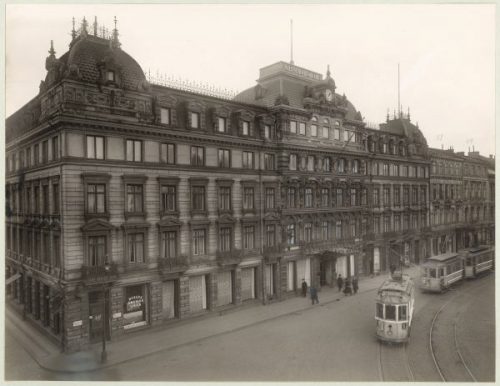
At the Hotel Grand Haglund we were met by Elsa Thomsen, Aunt Park’s niece. We have a beautiful big room & bath at this hotel.
After lunch we took a long walk up the main shopping street. Lots of jewelry & silverware but most merchandise-including food stores rather poor people go in for returning wear here, and we saw a whole window display of morning hats. Crowds of children, apparently school excursions from neighboring town or countries march thru the sts. under the guidance of a few teachers, all very orderly. We sat for a while in a little park beside the Gota Canal watching the boats & the people in the park. Several men, apparently high, tried to talk to us & Elsa interpreted for one of them who said he liked to impress the ladies. I’m afraid the result was quite in reverse of his intentions.
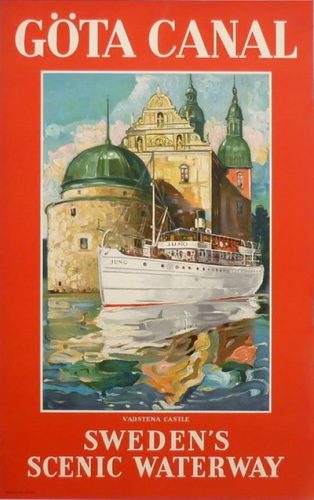
It is quite cool 51o.. We went back to the hotel to rest & after dinner our chauffeur took us to the airport see Elsa off to Copenhagen. On the way we rode out to a quaint little fishing village on the North Sea. Returning to Gothenburg, Mr. Anderson showed us many interesting places, including several old churches, a beautiful monument of a sailor’s wife on a tall column, looking out to sea in search of her husband, which dominates the harbor. Below her stood out the clean white hulk of the Gripsholm, largest ship in port.
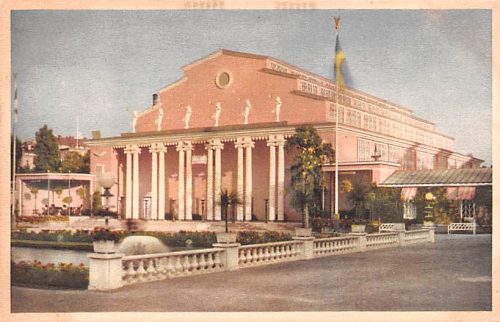
We saw Liseberg, a large & gay looking amusement park, the main hospital where Mr. Anderson told us you can get the finest surgical or other care with nursing for 2 ½ crowns (roughly 50c a day) The fine residential section high on the hills is very beautiful, most of the homes have walled-in gardens. Saw the new Park Lane Hotel, big & as modern as anything in N.Y. The apt. houses for the middle & poorer classes are also very modern, clean & cheerful looking. Two rooms + bath rent for about $30 a month but the poorer families must double up.
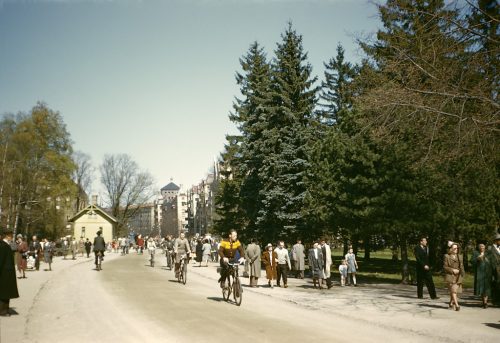
There is a lovely park, Slottskogen, ordinarily closed to vehicles but Am. Ex. Has special permit to drive thru & we had a fine view over the city. The flowers are lovely & everything is so green in this country. Random impressions: Two mailboxes at the corners instead of one, a blue one for parcel post, a red one for ordinary mail & small mail boxes attached to the fronts of trolley cars. Bicycles with small seats for & aft for the little ones, also many couples riding tandem cycles & many cyclists holding dogs on the leash, parked automobiles wrapped up in gray plastic material-the same as their rain coats – to protect them from the weather, as garages are hard to get. Houses not yet finished but as soon as the roofs are on, they put up a big round wreath from which streamers flutter & this marks an important ceremony. Many people still wear heavy warming in this country.
June 18, 1950
En Route to Karlstad
We left Gothenborg after breakfast, about 10:30, a fine ride thru Kungalu, Trollhattan a picturesque place on Trolliatte Canal where there is a beautiful waterfall & hydroelectric plan. The people are out in droves walking, cycling, some in cars, many in boats on the canal. Then thru Mellerud, Amal, Saffle largest town in this province of Delalund to Karlstad.
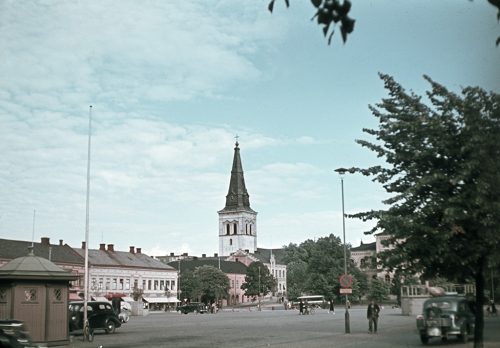
We have a lovely room and bath at the Stadshotel. Our balcony overlooks the Klaralven canal. I am fascinated watching the steady stream of traffic-mostly cycles- pouring over the bridge & the boat & log rafts floating up the canal. Lumber seems to one of the main industries of Sweden. On all the lakes, rivers & canals there are thousands of logs tied together floating down stream. After a good dinner we walked around the street till bedtime, a nice, clean, quiet town.
June 19, 1950
Karlstad
Started out after breakfast on a lovely ride thru lake& mt. district to Sunne. This is indeed a smiling land. Neat small farms, sleek cattle, modest but attractive homes with nice flower gardens.
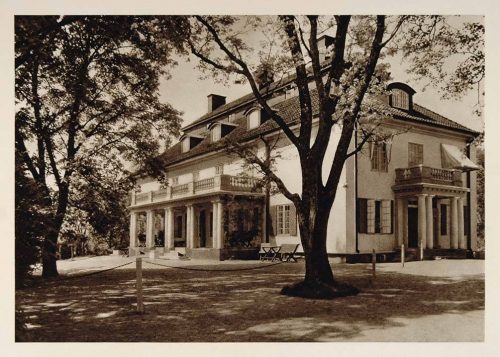
Not far from Sunne, ee visited the home of Selma Lagerlof. One of the lady caretakers gave me a little composite book in which she had carefully written in broken English a detailed account of all the articles of importance in every room together with their commemorative interest. On the first floor we saw a very beautiful parlor or drawing room furnished in the style of country gentry. This room contained a fine portrait & marble bust of the author as well as her piano. This is where she & her family gathered in the evenings to sing & play & read. There is also a dining room (interesting collection of china in the cupboards) a small breakfast room & kitchen with any shining copper accessories.
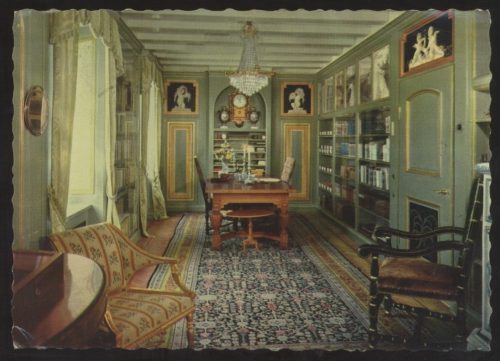
We saw a case of her medals including the Nobel decoration & other mementos. In the garden is a little lake & a pair of peafowls in a cage. This bird is symbolic of something connected with the cure of a malady from which she suffered. We had lunch at a very nice restaurant in Sunne where we sat on a porch overlooking a garden with the river just beyond.
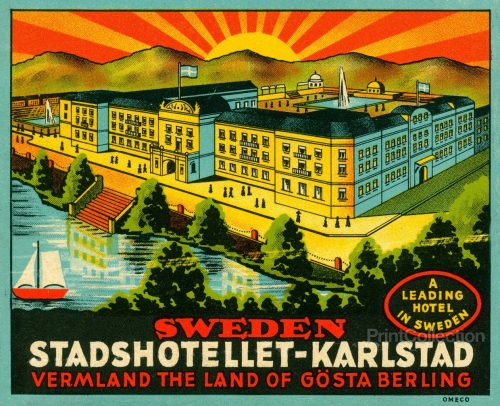
We came back to Karlstad by another pretty route skirting Lane Fryken. We saw the varmlands museum in the little park back of Stadshotel in Karlstad & the old church (Domkyrkan built circa 1723) The Stadshotel is also very interesting. The doors on main floor are glass etched in beautiful patterns, the outer doors & stair rails are brightly polished wrought brass. The dining room has interesting murals of life size figures illustrating various folk agendas & there is a lovely garden in back with tables & chairs where one may be served. In the upper hall are 2 interesting old chairs with leather gauntlets fastened to the back of the leather seat and an inscription in old Swedish carved on the arch forming the back rest.
June 20, 1950
En Route to Falum
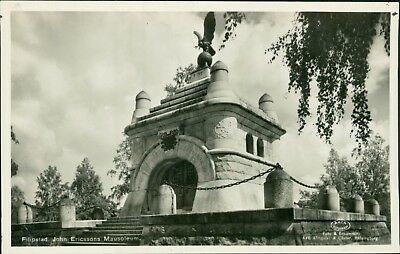
We left Karlstad at 10:15 and made our first stop at Filipstad a very pretty little town of about 20,000. Here we saw the very imposing tomb of John Ericsson, inventor of the propeller, in a cemetery on a high hill overlooking the river. It is like a lovely park & people ae sitting on the benches. The air is fragrant with purple & white lilacs. These grow everywhere in profusion on trees rather than bushes & seem now to be at the height of their season as are also the lovely pink hawthornes. The people here seem to adore flowers. They carry them in big bunches on their cycles, every window in every home is filled with flowering plants, + there are more florist shops in the towns (Blommor) than anything else. Among the flowers most commonly seen in the gardens besides lilacs are roses, begonias, petunias, geraniums, & a few unfamiliar ones.
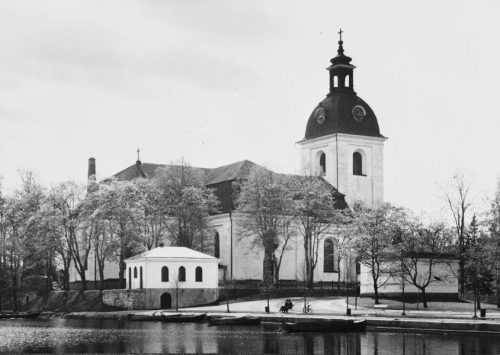
We had lunch in a very attractive new restaurant on a hill overlooking the town. There is a nice old church here. In the country the churches are quite unique, of wood with the shingles in spires. We passed thru several little towns on our way of Falum. (Hallefors Bruk, Ludvika, Kopparsburg, Gaingesborg) in one of which we stopped to watch an auction sale. A man stood on the steps of a country hotel which was going out of business and hit his hammer on the stair rail as he held up table cloths & napkins & threw them to the customers for 3 or 4 dollars. A crowd historicwas standing around + a little boy detached himself from the rest & came & sat in the car with me pretending he was driving & talking in Swedish. He didn’t seem a bit disconcerted that I didn’t understand him & he didn’t understand me. I gave him some candy + thanked me. The children here are so polite & curtsy for the least favors, the boys as well as the girls.
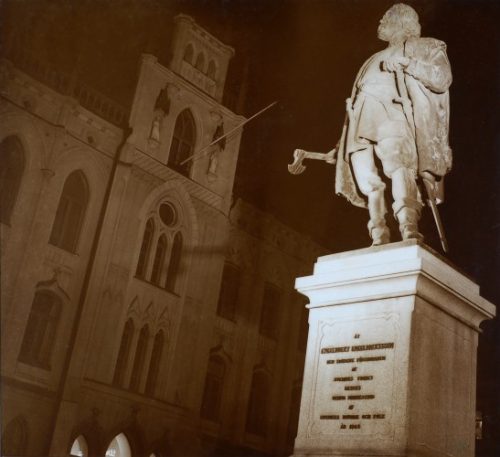
Arrived in Falum about five o’clock & went to the Stadshotellet (the porter wanted to push me on the trunk rack) a very fine establishment for so small a town. We have a lovely large room with bathtub on one side and toilet-washstand on the other. We rode around around the town, a nice shopping district, statue to Engel Engleson the liberator. We had dinner at a lovely summer restaurant where they served the most delicious hors-d’oevures and the small orchestra played very good music.
Thanks for reading “Traveling with Grace,” a series where we’re sharing (and annotating) posts from the travel diaries of Grace Amelia Hecht, native Baltimorean, b. 1897 and d. 1955. As mentioned in my introductory post transcription errors sometimes occur and I’ve made my best guesses where possible, denoted by [brackets]. – Rachel Kassman, marketing manager
